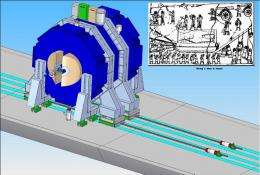Silicon Detector Validated, Moves Forward

(PhysOrg.com) -- Two of the three detector design concepts for the proposed next linear collider have been validated by the International Detector Advisory Group, and their conclusions endorsed by the International Linear Collider Steering Committee. These detector designs had been presented to the IDAG earlier this year in Letters of Intent, which outlined the type of detectors the researchers wish to build and the physics performance to be expected from each.
"This was a challenging and time consuming process," said physicist John Jaros, who co-heads SLAC's Linear Collider Detector department with Marty Breidenbach and also serves as a co-spokesperson for the Silicon Detector, one of the two validated design concepts. "All of these efforts ran on heroes who accomplished a lot with relatively little in the way of resources."
The validation process ensured that the proposed detectors can do justice to the physics that would be undertaken with the next linear collider, and that the proposing group has the ability and resources to complete a full detector design. Researchers working on the two validated detector concepts will now begin creating much more detailed designs.
SLAC plays a significant role in the design of the Silicon Detector. Smaller than the other proposed detectors, the SiD is built around a compact silicon tracker, highly pixilated electromagnetic and hadronic calorimeters, and a high field magnet. Together, these components would precisely track and measure particles streaming from the collision point.
"The collaboration was pleased with the quality of our submission—it's good work and a real step forward," said Jaros. "We're also very appreciative of SLAC for making computing resources available to complete the validation process."
Also validated was the International Large Detector. Designed by a group of mostly European and Asian collaborators, the ILD is an amalgamation of two former detector designs, the so-called “LDC” and the “GLD,” both of which were based on a large gaseous tracker.
The SiD and ILD collaborations are now ramping up efforts to complete the detailed baseline detector designs. These designs will be included in the next linear collider technical proposal, planned for completion in 2012.
"There's an awful lot to get done before then, including the proof-of-principle R&D that will demonstrate that our ideas will actually work," said Jaros. "But I have no doubt that we can succeed."
More information: silicondetector.org/display/SiD/home
Provided by SLAC National Accelerator Laboratory (news : web)


















